The Infinite Horizons of Stomu Yamash'ta
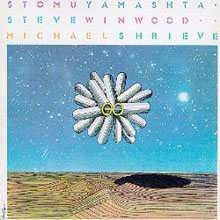
by Gregor Meyer (Part 2 of 4)
Analyzing Yamash'ta's musical career via his recorded output would be a simpler task if his recordings fell into neatly defined periods. Throughout the first half of the '70s, Yamash'ta's avant garde releases overlapped the rock-fusion albums almost at a 1:1 ratio. With major label rock publicity being the beast that it is, there's little wonder that Yamash'ta is most commonly associated with the splashier albums of more ostensibly "conventional" appeal. In fact, it's a testament to his talent that he was able to successfully straddle both genres for as long as he did. Between 1971 and 1975, twelve albums were released under his name, with another five showcasing him as featured performer. This article will focus on his Neo-Classical and Avant Garde works from that period (a survey of his Progressive albums will be the subject of a future article).
The Early Albums
Nineteen Seventy-one would be Yamash'ta's busiest year and the most prolific of his career. In addition to dozens of performances, he recorded two film scores and six albums, two of which were recorded in January alone.
Yamash'ta's recorded debut was titled Percussion Recital, released in Japan only in 1971. Yamash'ta performs with Tousha Suihou on noukan (a Japanese flute), and Tousha Roetsu on tsuzumi (an hourglass-shaped drum). It was soon followed by The World of Stomu Yamash'ta, which was recorded live at the Tokyo Metropolitan Concert Hall on the same date as Percussion Recital, January 11th. It features one work per side: Tircuit's "Variations from 'Odoru Katachi'" and Yamash'ta's own "Hito." It's easy to picture Yamash'ta working his way down a line of instruments in "Variations," as the opening shimmers of bells and chimes evolve into delicate rumblings and undulating waves of drums and metalwork, accentuated by an occasional flute before settling down again. By comparison, "Hito" has a much more ritualistic feel, with a decisive interplay between brittle flutes and the spectrum of percussion at work one can almost hear Yamash'ta's concentration between the eruptive drumming crescendos and the gentlest of bell and gong tinkerings. The success of both albums would lead to Uzu: World of Stomu Yamash'ta Vol. 2, also released that year and featuring Tousha Suihou and Roetsu as well. This album presented three works: the side-long title piece, an original composition, along with the improvisation "Nenbutsu" and Brouwer's "Exaedros II." None of these albums would receive release outside of Japan or reissue in any format.
Not long after performing Takemitsu's composition/event "Blue Aurora for Ichiyanagi Toshi" at Bunka Kaikan Small Hall in Tokyo, Yamash'ta and Sato Masahiko made good on their promise back in Boston, and on January 27th recorded a single session with the 17-member New Herd Orchestra. Sato notated the bulk of the music for the session, but left plenty of room for Yamash'ta to improvise. The resultant album, Metempsychosis, has been described by Julian Cope as "a kind of Godhead union between Sun Ra and the Cosmic Jokers."8 Like its predecessors, it too has only been released in Japan and cries out for a wider reissue.
Back in London, Yamash'ta treated audiences at Queen Elizabeth Hall to a stirring performance on March 12th, featuring Brouwer's "Exaedros II," Tircuit's "Odoru Katachi," the London premiere of Takemitsu's "Blue Aurora," which had Yamash'ta playing while walking up and down the aisles, followed by a blue spotlight. The evening also included the world premiere of Davies' "Turris Campanarum Sonantium," and Yamash'ta's own "Nembutsu" (a Japanese word for the sound of a Buddhist prayer). It was never recorded, but a review of the event offers an intriguing description: "Yamash'ta hung a bright metal sliver from his wrist: a short, mysterious ritual accompanied by the taped rolling of a high bell."9
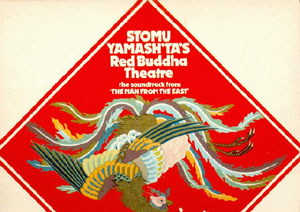
The all-percussion Red Buddha begins quietly enough, slowly building from clouds of soft clutter to a swirling fog of controlled cacophony. The album was recorded between April 11 and 14, 1971 on eight channels, the first containing the bulk of the instruments recorded live, and the remaining channels filled in later over live playback of the previously recorded tracks. Although completely notated, Yamash'ta changed instruments and rhythms every 30 seconds according to time cards held up by an assistant during the recording. A steady tabla beat permeates the title track, soon augmented in rhythm by additional channels of drums, chimes, and a feverishly plucked mouth harp. The effect is almost dizzying, an experience exponentially heightened when heard in the Quadraphonic pressing. Like a tropical storm eventually coming to rest, the instruments ebb and only punctuate the beat with an occasional staccato before the waters are calm again. "As Expanding As," the flipside, opens with the soothing rolls of a steel drum and quickly surrounds the listener with a fervid chattering from all directions. Wood blocks, bells, cymbals, and a mélange of other objects soon drench an alternating two-tone theme that suggests a Joe Jones construction using Harry Partch's instruments. It's an exceptional record that gained worldwide release over the next two years as Yamash'ta's exposure grew throughout various circles.
Stirred by the avant garde activity around him, Yamash'ta wanted to convey the new possibilities that were ripe in modern music. He envisioned a handful of musicians who would instinctively channel the fusion of Eastern and Western musics into something uniquely Japanese, bridging the traditional and modern. Through Takemitsu, he met Kosugi Takehisa, who had told the composer that he was intrigued by the idea of collaborating with Yamash'ta. Kosugi had already been exploring the boundaries of lengthy drone-improvisations with his Taj Mahal Travellers collective and was keen to experiment with other musicians. Recruiting Sato Masahiko and Sakurai Hideakira, who played on the Four Jazz Compositions album with Sato and New Herd Orchestra the previous summer, Yamash'ta organized an all-night concert at Yamaha Hall on April 18, just four days after completing the Red Buddha sessions. Billed as "Yamash'ta and the Horizon" (so named for the "new horizon" of Japanese music that Yamash'ta forecasted), the four men played for six hours beginning at midnight, in front of a specially-invited audience of mostly artists and musicians. As edited down to a single LP, Sunrise from West Sea offers only a tantalizing fragment of the evening's proceedings.
Opening with a handful of sinewy violin waves that achingly evoke both Taj Mahal Travellers albums, Sunrise saturates the listener with gaseous clouds of electronics, various percussion instruments, electric koto, electric violin, organ, and shamisen (a kind of three-stringed guitar) that gel into eerie art-noise soundscapes. The four players only discussed structural concepts in advance, wanting to leave as much open for inspiration as possible on the night of the performance. Each seems content with letting the others explore individual spaces, rather than layering their collective efforts into a dense cacophony. Both sides capture an arresting maelstrom of adrenalized percussion, ice-pick organ, theremin-sounding tones, tribal hand drumming, cosmic violin snaking, processed chanting, and occasional radio pick-ups, all laced with bubbles of calming serenity in a word, it breathes. One of the most fascinating and rewarding recordings in Yamash'ta's career, it holds up to infinite listening.
With agents in Japan and Europe, Yamash'ta's touring schedule showed no signs of abating. In May of '71, he performed at the Contempo 71 festival in Los Angeles with the L.A. Philharmonic under Zubin Mehta. The L.A. Times review of his performances Morton Feldman's "The King of Denmark," Tircuit's "Concerto" and his own "Prisms" was nothing less than ecstatic:
"At one time he may rap his mallet on metal plates of the cariva while in the other hand, in a yo yo motion, dangle another one of his instruments a spring taken from an old clock near his house in London. Together they produce a wiry and muffled sound drum sound. To accentuate this combination, he blows on a wooden whistle or rotates the handle of a mallet around the rim of a Japanese bronze bell to produce a rising, screaming pitch."10Another reviewer noted that the orchestra sat "in awed silence" during his solo in Tircuit's "Concerto," "an exhausting, fascinating, ritualistic orgy" during which Yamash'ta seemed to play "as if his very life depended on it. (He is only 24 but, at this rate, it may be a miracle if he sees 30.)"11
Later that summer, the Ravinia Festival sought to repeat their previous success and commissioned another work for the rising 24-year-old, this time from Takemitsu. Inspired by the five-starred constellation, "Cassiopeia" calls for the orchestra and soloists to be arranged in W-shaped pattern on the stage, with the percussionist centered at the middle point. The elaborate and highly engaging work demands an equal amount of theatrics and creative instinct from the soloist, with graphic notation and conceptual instructions infusing the score for 40+ percussion instruments both pitched and unpitched. Yamash'ta and conductor Ozawa Seiji recorded the piece in Tokyo two weeks before the Ravinia premiere with the Chicago Symphony Orchestra, which proved no less spectacular than his previous appearance. "At one climax he is shaking the bells on his wrist, playing the kettle drums with one hand and foot, beating a second drum with the other foot and playing melodic fragments on the temple blocks with the remaining hand."12
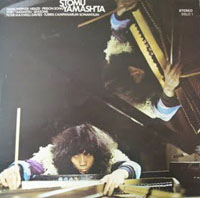
By 1972, Yamash'ta had relocated his home base to London, leading a double life as avant garde percussionist extraordinaire, and composer-director of highly original jazz-rock stage productions with his 30-member Red Buddha Theater. Decca Records rose to the occasion of releasing Yamash'ta's self-titled Western debut on their Editions de L'Oiseau-Lyre imprint. Stomu Yamash'ta is also known as Henze/Takemitsu/Davies for the three composers whose works are performed on the record, and whose names appear with Yamash'ta's on the sleeve in lieu of a formal title.
Composed for live percussion, piano, bamboo flute, and pre-recorded tape, Henze wrote "Prison Song" especially for Yamash'ta and this album in November 1971. Using a poem from Ho Chi Minh's Prison Diary as inspiration, Henze intended for the music to be subjugated by the tape and percussion interplay. Between Yamash'ta's glossolalic cries, the wistful sighs of the bamboo flute, and the manic percussive flailings, easily suggestive in themselves of the classic tin cup against metal bars imagery, the piece breezily grants Henze's wish of conveying a tormented soul desperate to signify its existence beyond imprisonment. In his quest to achieve just the right sound, Yamash'ta dropped marbles onto piano strings and played them with mallets, a photo of which graces the album's back cover.
As Takemitsu's "Seasons" was by now a staple of Yamash'ta's concert appearances, it was natural for it to be included on the album. A thoroughly stimulating work, "Seasons" is one of the most delicately structured pieces composed for Baschet structures, and one that best capitalizes on the delicacies of Yamash'ta skills rather than the bombast of his circusy antics. Often mistaken as representative of the seasons themselves, the piece is meant to convey the transitions between them, each a cycle in itself with a unique set of characteristics. Yamash'ta's playing expresses as much personality as the structures: the shimmering sheet metal of pouring rain and distant thunder, the windy gusts of the glass trombone, or the gentle flutter of falling leaves. A few years later, Yamash'ta would record a four-player version with his old instructor Michael Ranta, plus Yamaguchi Yasunori and Sato Hidehiko. So taken by this performance was Yamash'ta that another version was recorded at the same time featuring the other three performers only, the tape of which he would perform against in solo concerts.
(In August 1972, NHK aired an episode of the series "Geijutsu Gekijo" ["Fine Arts Theater"] called "In Motion," featuring footage of Yamash'ta performing "Seasons"- curiously, the footage is played silent, designed to highlight Yamash'ta's bodily movements without auditory distraction.)
Peter Maxwell Davies' "Turris Campanaram Sonantium" was also written especially for Yamash'ta in December of 1970, scored entirely for bells and metal surfaces. A background drone in the second section is created by a leather-covered mallet continuously rubbing the rim of a Japanese temple gong; in the third section, the drone is continued by a tape of a Buddhist monk chanting, chosen by Yamash'ta for this recording. "Turris" is structured similarly to Steve Reich's "Drumming", though without the fixed rhythm: much like a bell-curve, the faintest of individual sounds emerge gradually from silence, with more and more joining forces until they swell in the midsection, a dizzying headrush of every imaginable sonority from all directions. Again, the sense of control is remarkable, quite dramatically so from the unrestrained exasperation of Red Buddha. Suddenly, all is quiet again as the gentlest of tinkerings fade into space. According to Davies biographers, the score for "Turris" has been lost, forever consigning Yamash'ta's performance to history.
They would collaborate again the following year, when Davies scored Ken Russell's Artaudian grand-guignol masterpiece The Devils. Yamash'ta performs on the score and can be seen briefly in a BBC documentary on the making of the film. On occasion, Yamash'ta performed Davies' concert version of the score, but sadly never recorded it, and a soundtrack album to Russell's tragically maligned film was never released.
By this time, Yamash'ta's name became almost synonymous with the Baschets' Sculptures Sonores. Always looking for new sounds to express what conventional instruments could not, Yamash'ta loved playing the sculptures and did so at every opportunity. When Hollywood composer John Williams, just a few years shy of his career taking astronomic turns by scoring Jaws and Star Wars, wanted to use them for Robert Altman's 1972 film Images, his friend Andre Previn told him to look no further than Yamash'ta, at that time living in Paris. The film deals with a psychologically fractured woman whose impending breakdown is rendered in a series of jarring vignettes that become increasingly difficult for her (or us) to distinguish from empirical reality. Williams had conceived of a score that would alternate styles schizophrenically in accordance with the main character's oscillation between reality and fantasy. When Yamash'ta agreed to be a part of the project, one of the most unique film scores was born.
Written in the same A/B structure as the film itself, the atonal score gave Yamash'ta room to improvise in addition to Williams' graphically scored percussion sections. Stabbing, strumming, scraping and bowing his way into the orchestra's baroque passages, Yamash'ta swoops and lingers throughout the score with sinister presence as both demon spirit and bird of prey, and clearly relishes every moment of it. Baschets, flutes, wood chimes, drums, and bells, augmented with an occasional chant and guttural groan ("the Japanese style of the percussion, the resonance of the instruments, and his chest," according to Williams13) all combine to sound both primal and alien in effect, casting spookier shadows on the psyche than any of Williams' Hollywood gloss. It's an unusually unsettling work for a Hollywood film score, and unsurprisingly the least popular among traditional Williams fans. It was nominated for an Academy Award for Best Original Score, no doubt at least partly earned by Yamash'ta's involvement. Williams is credited as the sole composer; Yamash'ta requested the "Sounds Produced by " credit, telling Williams "I'm trying to get away from the percussion; I want to expand my activities..."14
The power of Yamash'ta's presence in the score makes it especially tragic that the Images album didn't receive a commercial release for 35 years. At the time, an LP of simple design was pressed privately by Williams and given to select members of the voting Academy most likely an edition of 200 copies or so and was soon after bootlegged in an inferior and more common pirate pressing. After a bootleg CD edition, it finally received a legitimate release on the Belgian label Prometheus in December 2007. Limited to 2,000 copies, its source is de-clicked vinyl, but the label doesn't specify which pressing was used.
The next few years would be dominated by Yamash'ta's concurrent fusion projects. The success of Come to the Edge enabled Yamash'ta to explore the visual aspects of his music on a much grander scale. Enlisting over 30 stage actors from Japan, he formed the Red Buddha Theater to produce elaborate productions combining elements of Noh theater, kabuki, mime, and live jazz-fusion performance. Yamash'ta trained with his actors daily ("we are not Tokyo Kid Brothers," he was quoted at the time), and after playing to sell-out crowds in Paris, the show went to London and eventually the U.S.. So demanding was the schedule that Yamash'ta formed the band East Wind with Brian Gascoigne in order to release albums in addition to the stage works. It's worth mentioning that some sparing references were made to Yamash'ta touring with Franco Battiato in the spring of 1972, but in fact they only shared a few billings together at festivals, never performing together.
As the popularity of Red Buddha Theater soared, Yamash'ta extended himself less and less to contemporary classical and the avant garde. The sole exception to this seems to be the ballet "Shukumei," scored for the British Royal Ballet in 1975. The following year saw Yamash'ta's name appear in the credits for Nicolas Roeg's film The Man Who Fell to Earth. Contrary to popular notions, Yamash'ta did not contribute any original music to the film, which instead used several tracks from his albums with Come to the Edge and East Wind.
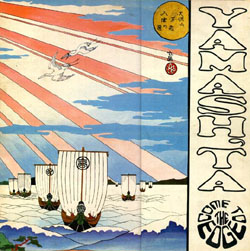 |
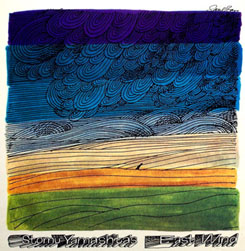 |
A meeting earlier in the decade with EMS founder and synth pioneer Peter Zinovieff introduced the world of the synthesizer to Yamash'ta, who was immediately taken with the range of the instrument, but found little occasion to incorporate it into his repertoire at the time. The opportunity came when a chance meeting with Santana drummer Michael Shrieve led to the formation of the space-fusion group Go, which soon added to the ranks Klaus Schulze, Steve Winwood, Al Di Meola, and Rosko Gee (bassist on Traffic's '70s swansong When the Eagle Flies and soon to be Can's bassist in the decade's closing years). For Yamash'ta, Go represented the culmination of his attempts to fuse rock, jazz, and the avant garde "everything up to now was practice," he says in the first album's liner notes. During their brief existence, Go's popularity was wider than any of Yamash'ta's previous projects (in part, no doubt, to Winwood's presence), generating two studio albums and a double-live set in between. It seemed as if Yamash'ta and Go were poised for a long and lucrative tenure by 1977, but all that was to change almost as swiftly as it began.